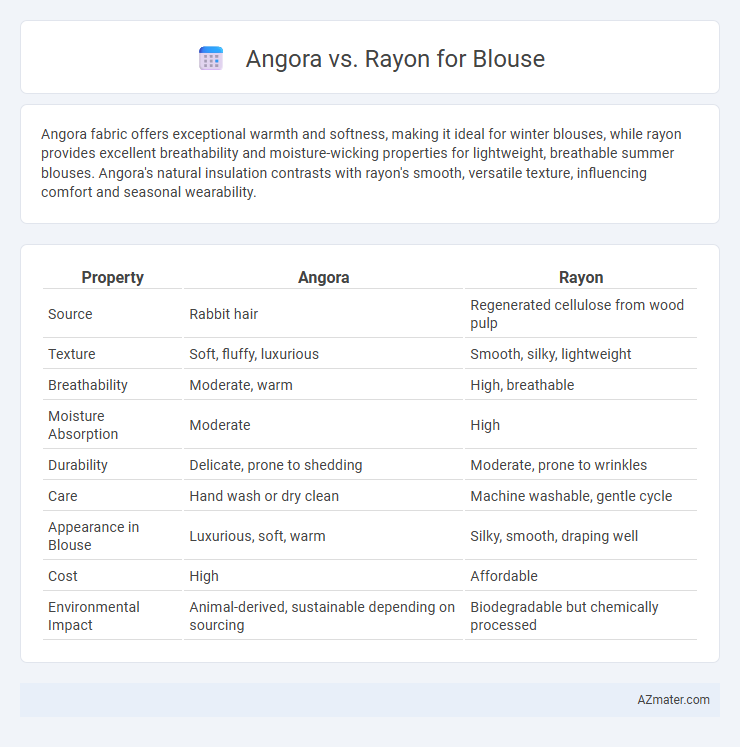Angora fabric offers exceptional warmth and softness, making it ideal for winter blouses, while rayon provides excellent breathability and moisture-wicking properties for lightweight, breathable summer blouses. Angora's natural insulation contrasts with rayon's smooth, versatile texture, influencing comfort and seasonal wearability.
Table of Comparison
| Property | Angora | Rayon |
|---|---|---|
| Source | Rabbit hair | Regenerated cellulose from wood pulp |
| Texture | Soft, fluffy, luxurious | Smooth, silky, lightweight |
| Breathability | Moderate, warm | High, breathable |
| Moisture Absorption | Moderate | High |
| Durability | Delicate, prone to shedding | Moderate, prone to wrinkles |
| Care | Hand wash or dry clean | Machine washable, gentle cycle |
| Appearance in Blouse | Luxurious, soft, warm | Silky, smooth, draping well |
| Cost | High | Affordable |
| Environmental Impact | Animal-derived, sustainable depending on sourcing | Biodegradable but chemically processed |
Introduction to Angora and Rayon Fabrics
Angora fabric, derived from the soft, silky hair of the Angora rabbit, is highly valued for its warmth, lightweight feel, and luxurious texture, making it an excellent choice for blouses that require a premium, cozy touch. Rayon, a semi-synthetic fiber made from regenerated cellulose, offers exceptional breathability, smoothness, and vibrant dye absorption, creating a breathable and comfortable option ideal for casual and formal blouses. Understanding the distinct characteristics of Angora and Rayon aids in selecting the right fabric based on warmth, texture, and drape preferences for blouse designs.
Origins and Production Methods
Angora fabric originates from the Angora rabbit, prized for its fine, silky fibers harvested through gentle combing or shearing. Rayon is a semi-synthetic fiber derived from cellulose, primarily wood pulp, processed via chemical treatment in the viscose method or modern lyocell process. The natural sourcing and hand-harvesting of Angora contrast sharply with Rayon's industrial production involving chemical regeneration of plant-based cellulose.
Texture and Feel Comparison
Angora fabric offers a soft, plush texture distinguished by its natural warmth and lightweight feel, ideal for cozy yet breathable blouses. Rayon provides a smooth, silky texture with excellent drapability, promoting a cool and flowing comfort suitable for stylish, breathable blouses. Comparing the two, Angora delivers a luxurious, fuzzy softness perfect for colder climates, while Rayon excels in softness combined with moisture absorption, making it suitable for warmer weather.
Breathability and Comfort
Angora offers excellent warmth and softness but has lower breathability, making it less ideal for blouses worn in warm climates. Rayon, derived from cellulose fibers, is highly breathable and moisture-absorbent, providing superior comfort and airflow for hot weather. Choosing rayon for blouses enhances comfort due to its lightweight, smooth texture and ability to wick sweat away from the skin.
Durability and Longevity
Angora, derived from the Angora rabbit, offers a luxurious softness but tends to be less durable than rayon due to its delicate fibers that can pill and wear quickly with frequent use. Rayon, a semi-synthetic fiber made from cellulose, provides greater durability and resilience, maintaining its shape and color over extended wear and multiple washes. For blouses prioritizing longevity, rayon is a superior choice, while Angora is best suited for occasional, gentle wear to preserve its plush texture.
Maintenance and Care Requirements
Angora blouses require delicate maintenance, including hand washing with gentle detergents and avoiding high heat during drying to prevent fiber damage and shedding. Rayon blouses demand careful care as well, preferably hand washing in cold water and air drying, since the fabric is prone to shrinking and losing shape when exposed to heat or rough handling. Proper storage, such as avoiding hanging Angora to maintain fiber integrity and folding Rayon to prevent stretching, enhances the longevity of each garment.
Cost and Affordability
Angora is a luxury fiber derived from Angora rabbits, often costing significantly more due to its softness and warmth, making it less affordable for everyday blouses. Rayon, a semi-synthetic fiber made from cellulose, is much more cost-effective and widely used in affordable blouse production due to its versatility and lower price point. Choosing rayon over Angora allows consumers to access stylish blouses at budget-friendly prices without sacrificing comfort.
Eco-Friendliness and Sustainability
Angora, derived from Angora rabbits, is a renewable natural fiber known for its biodegradability and lower environmental impact compared to synthetic alternatives. Rayon, a semi-synthetic fabric made from cellulose, often involves chemical-intensive production processes that can harm ecosystems and increase pollution. Choosing Angora for blouses supports eco-friendliness through sustainable animal farming practices, while Rayon's sustainability varies depending on the methods used in its manufacture and sourcing.
Best Uses for Blouse Styles
Angora offers a luxurious softness and excellent insulation, making it ideal for warm, cozy blouses perfect for cooler seasons or layering styles. Rayon provides a smooth, breathable texture with excellent drape, suited for flowing, lightweight blouses that prioritize comfort and elegance in warmer climates. Blouse designs benefiting from Angora blend include structured or textured styles, while Rayon excels in fluid, casual or formal blouses with vibrant prints.
Which Fabric is Right for You?
Angora offers a luxurious softness and excellent insulation, ideal for cooler weather blouses, while rayon provides a lightweight, breathable feel perfect for warmer climates. Consider durability and care requirements: angora requires delicate handling and may cause allergies, whereas rayon is easier to maintain but can lose shape over time. Choose angora for cozy, elegant wear or rayon for affordable, versatile, and comfortable everyday blouses.

Infographic: Angora vs Rayon for Blouse
 azmater.com
azmater.com